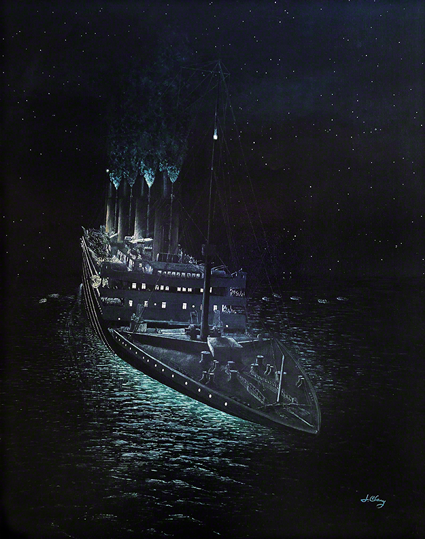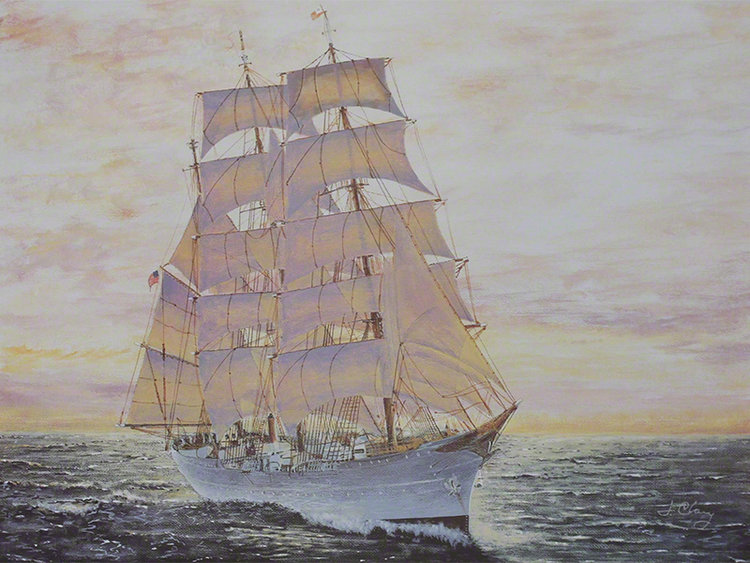One of maritime artist, Jim Clary’s paintings of the Titanic
I was seventeen years old when my father returned from the adventure of his lifetime. And even after all these years, I recall his face as he watched mine watch a videotape of the unmanned submarine moving along the floor of the Atlantic ocean. I remember the extreme darkness pressing hard against the lights of the sub. I remember the particles floating through the water that reminded me of insects at dusk. I remember asking him what the scraping sound was. And then I remember the sudden jolt as the camera swung in the opposite direction and the boulder that came into view.
“Do you see that? Do you see that boulder?”
“Yeah I see it.”
Then his signature chuckle and the way he hunched his shoulders and leaned forward like he was about to tell you the plan that was going to get us all sent to the principal’s office. “Well...that’s not a boulder, Todd. That’s a propeller blade. When I saw this, I realized we found her.”
“1:40 a.m. Titanic Time, April 15, 1912” | 1980 | Original: Sold | Print edition: Lithograph | Size: 32 1/2” x 25"
Now, I already knew they’d found her because that was the first thing he said when mom and I picked him up at the airport — fresh off the expedition and 20 pounds lighter thanks to seasickness. But hearing him say it and seeing the look on his face, I now realize I was looking at a lifetime of passion fully bloomed.
Titanic Painting
He was a lot more childlike and animated at home than his public persona, Cap’n Jim (aka Jim Clary). That is, unless the topic was the Titanic. If that was the conversation, you’d experience the side of dad that completely upended his usual reserve. Because when it came to his lifelong passion for all things nautical, nothing arrested his attention like that ship. And by the time he put brush to canvas on his now-famous Titanic painting, she’d become a part of our family’s daily diet. He then seized my mind and painted the scene, the mood, and the setting of the things leading up to that moment: how he couldn’t sleep the night before the expedition and decided to go for a walk. How the fog rolled in and enveloped him to guide his blind steps to the Titanic Memorial Graveyard on South Street. How the dolphins didn’t follow them out of port to signal the first of many bad omens. How the captain of the search vessel protested the entire adventure because ‘you don’t disturb a graveyard.’ How the Atlantic declared the attempt to locate her a holy violation and abused the vessel for four days with seven low-pressure systems over the search area.
Titanic Location Coordinates
As the expedition artist, Jim Clary secured his position aboard the search vessel by convincing the sponsor of the expedition he could portray what they would find in strategically released illustrations and paintings depicting the discovery. And though he was a welcome addition he made sure to keep himself out of the way of the scientists and technicians. That is, until their time was up and they’d decided to return to port empty-handed. It was then that dad decided to offer a hypothesis on the Titanic location coordinates he’d formed during his years of personal research into that tragic night.
In short, there was a single claim that after she’d struck the iceberg, she came to a complete stop. But then, shortly thereafter, restarted her engines and sailed at full steam for approximately 45 minutes. It was mentioned only briefly during the hearings and summarily dismissed as inconsequential — but now recorded for all time. And for some reason and entirely true to form, dad catalogued the bit of information having no idea its significance.
Except that the search was a failure. The Titanic was not where she should have been according to the prevailing data, the weather in the North Atlantic was making it very clear that the season was at an end and time to return safely was of the essence, and worst of all, the lines of one of two the three-million dollar unmanned subs had snapped and plunged it into oblivion.
Jim Clary was nothing if not persistent. And, making his way to the leaders of the expedition, he explained his theory, suggested they were likely looking in the wrong place, and convinced them they had little to lose by putting it to the test. Hours later as the sub sent video images to the lab onboard, he’d decided to wiggle his way between bodies going over data and found his hands accepting and then passing one photograph after another.
Titanic Behind The Scenes
Maritime artist, Jim Clary
“You should have seen it! Computers whirring, scientist analyzing everything coming over the monitors, engineers passing one photograph after another as every few seconds the printer spit out images from the sub. The sonar device was also scanning the ocean floor in search for her. Then...all of a sudden someone hands me a photograph of a boulder. Except it wasn’t a boulder. They didn’t realize it but I did. I was stunned. My whole body went stone cold. I said it to myself but others heard the words. ‘...oh my God. We found her.’ Then everyone stopped. You could hear the systems and printer and other equipment still working, but everyone had stopped talking. ‘Who said that? Found what? Who said that!’ Then all eyes came to rest on me and boy was that a moment. I knew they thought it was just a big rock. But I know this ship. Like the back of my hand, Todd. ‘I did.’ I held up the photograph. ‘We found her. This isn’t a rock. This is a propeller blade. We found her. We found the Titanic.”
He went on to say that at that very moment several things happened at the same time. First, as the technicians fed the image back into the computers, the system analyzed the picture and concluded it was an exact match to the known dimensions of her propeller blades. And second, at the same moment, the sonar equipment began to draw. Something unmistakable and impossibly large. This intense real-life drama was what it was like to search for the Titanic behind the scenes.
And there it was on videotape after seventy-one years cloaked in total darkness.
And there he was, smiling with total satisfaction. After a lifetime of love for the sea, he’d help locate the final resting place of the most famous ship ever to sail.










